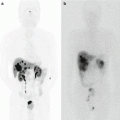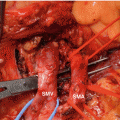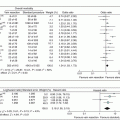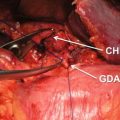Author
Premalignant lesion
n
Treatment
Median area of ablation, mm (range)
Outcome
Complications
Gan et al.
Cystic tumors of the pancreas
25
EUS-guided ethanol lavage
19.4 (6–30)
Complete resolution in 35%
None
Oh et al.
Cystic tumors of the pancreas
14
EUS-guided ethanol lavage + paclitaxel
25.5 (17–52)
Complete resolution in 79%
Acute pancreatitis (n = 1)
Hyperamylasemia (n = 6) abdominal pain (n + 1)
Oh et al.
Cystic tumors of the pancreas
10
EUS-guided ethanol lavage + paclitaxel
29.5 (17–52)
Complete resolution in 60%
Mild pancreatitis (n = 1)
DeWitt et al.
Cystic tumors of the pancreas
42
Randomized double-blind study: saline vs ethanol
22.4 (20–68)
Complete resolution in 33%
Abdominal pain at 7 days (n = 5) pancreatitis (n = 1)
Acystic bleeding (n = 1)
Oh et al.
Cystic tumors of the pancreas
52
EUS-guided ethanol lavage + paclitaxel
31.8 (17–68)
Complete resolution in 62%
Fever (1.52)
Mild pancreatitis (1/52)
Splenic vein obliteration (1/52)
Levy et al.
PNET
8
EUS-guided ethanol lavage (5 patients) and intraoperative ultrasound-guided (IOUS) ethanol lavage (3 patients)
16.6 (8–21)
Hypoglycemia symptoms disappeared 5/8 and significantly improved 3/8
EUS guided: no complications
IOUS-guided ethanol injection: minor peritumoral bleeding (1/3), pseudocyst (1/3)
Pai et al.
Cystic tumors of the pancreas + neuroendocrine tumors
8
EUS-guided RFA
Mean size pre-RFA, 38.8 mm vs mean size post-RFA, 20 mm
Complete resolution in 25% (2/8)
2/8 patients had mild abdominal pain that resolved in 3 days
Table 41.2
Endoscopic ultrasound administered non-ablative and antitumor therapies for pancreatic ductal adenocarcinoma
Author | Therapy | Patients | n | Outcome and survival | Complications |
|---|---|---|---|---|---|
Chang et al. | Cytoimplant (mixed lymphocyte culture) | Unresectable PDAC | 8 | Median survival: 13.2 months, 2 partial responders and 1 minor response | 7/8 developed low-grade fever 3/8 required biliary stent placement |
Hecht et al. | ONYX-015 (55-kDa gene-deleted adenovirus) + IV gemcitabine | Unresectable PDAC | 21 | No patient showed tumor regression at day 35. After commencement of gemcitabine, 2/15 had a partial response | Sepsis: 2/15, duodenal perforation: 2/15 |
Hecht et al. Chang et al. | TNFerade (replication-deficient adenovector containing human tumor necrosis factor (TNF)-a gene) | Locally advanced PDAC | 50 | Response: one complete response, 3 partial responses. 7 patients eventually went to surgery, 6 had clear margins, and 3 survived >24 months | Dose-limiting toxicities of pancreatitis and cholangitis were observed in 3/50 |
Herman et al. | Phase III study of standard care plus TNFerade (SOC + TNFerade) vs standard of care alone (SOC) | Locally advanced PDAC | 304 (187 SOC + TNFerade) | Median survival: 10.0 months for patients in both the SOC + TNFerade and SOC arms[hazard ration (HR), 0.90, 95% Cl; 0,66–1.22, P – 0.26] | No major complications, patients in the SOC+ TNFerade arm experienced more grade 1–2 fever than those in the SOC alone arm (P < 0.001) |
Sun et al. | EUS-guided implantation of radioactive seeds (iodine-125) | Unresectable PDAC | 15 | Tumor response: “partial” in 27% and “minimal” in 205. Pain relief: 30% | Local complications (pancreatitis and pseudocyst formation) 3/15. Grade 3 hematologic toxicity in 3/15 |
Jin et al. | EUS-guided implantation of radioactive seeds (iodine-125) | Unresectable PDAC | 22 | Tumor response: “partial” in 3/22 (13.6%) | No complications |
Table 41.3
Studies of cryoablation in pancreatic ductal adenocarcinoma
Study | n | Patients | Study | Outcome | Complications |
|---|---|---|---|---|---|
Patiutko et al. (non-English article) | 30 | Locally advanced PDAC | Combination of cryosurgery and radiation | Pain relief and improvement in performance status 30/30 | Not reported |
Kovach et al. | 9 | Unresectable PDAC | Phase I study of intraoperative cryoablation under US guidance; 4 had concurrent gastrojejunostomy | 7/9 discharged with non-intravenous analgesia and 1/discharged with no analgesia | No complications reported |
Li et al. (non-English article) | 44 | Unresectable PDAC | Intraoperative cryoablation under US guidance | Median overall survival: 14 months | 40.9% (18/44) had delayed gastric emptying. 6.8% (3/44) had a bile and pancreatic leak |
Wu et al. (non-English article) | 15 | Unresectable PDAC | Intraoperative cryoablation under US guidance | Median overall survival: 13.4 months | 1/15 patients developed a bile leak |
Yi et al. (non-English article) | 8 | Unresectable PDAC | Intraoperative cryoablation under US guidance | Not reported | 25% (2/8) developed delayed gastric emptying |
Xu et al. | 38 | Locally advanced PDAC, 8 had liver metastases | Intraoperative or percutaneous cryoablation under US or CT guidance + (125) iodine seed implantation | Median overall survival: 12 months 19/38 (50,9%) survived more than 12 months | Acute pancreatitis: 5/38 (one has severe pancreatitis) |
Xu et al. | 49 | Locally advanced PDAC, 12 had liver metastases | Intraoperative or percutaneous cryoablation under US or CT guidance + (125) iodine seed implantation. Some patients also received regional celiac artery chemotherapy | Median survival: 16.2 months 26 patients (53.1%) survived more than 12 months | Acute pancreatitis: 6/49 (one had severe pancreatitis) |
Li et al. | 68 | Unresectable PDAC requiring palliative bypass | Retrospective case series of intraoperative cryoablation under US guidance, followed by palliative bypass | Median overall survival: 30.4 months (range 6–49 months) | Postoperative morbidity: 42.9% |
Delayed gastric emptying occurred in 35.7% | |||||
Xu et al. | 59 | Unresectable PDAC | Intraoperative or percutaneous cryotherapy | Overall survival at 12 months: 34.5% | Mild abdominal pain: 45/59 (76.3%) |
Major complications (bleeding, pancreatic leak): 3/59 (5%) | |||||
Niu et al. | 36 (CT) | Metastatic PDAC | Intraoperative cryotherapy (CT) or cryo-immunotherapy (CIT) under US guidance | Median overall survival in CIT: 13 months CT: 7 months | Not reported |
31 (CIT) |
Table 41.4
Studies of photodynamic therapy in pancreatic ductal adenocarcinoma
Study | n | Study | Photosensitizer | Number of fibers | Number of ablations | Outcome and survival | Complications |
|---|---|---|---|---|---|---|---|
Brown et al. | 16 | CT-guided percutaneous PDT to locally advanced but inoperable PDAC without metastatic disease | mTHPC | 1 | Single | Tumor necrosis: 16/16 Median survival: 9.5 months 44% (7/16) survived > 1 year | Significant gastrointestinal bleeding: 2/16 (controlled without surgery) |
Huggett et al. | 13 + 2 | CT-guided percutaneous PDT to locally advanced but inoperable PDAC without metastatic disease | Verteporfin | 1 | Single (13) Multiple (2) | Technically feasible: 15/15. Dose-dependent necrosis occurred | Single fiber: no complications. Multiple fibers: CT evidence of inflammatory change anterior to the pancreas, no clinical sequelae |
Table 41.5
Studies of radiofrequency ablation in pancreatic ductal adenocarcinoma
Study | Patients | n | Route of administration | Device | RFA temp | RFA duration (min) | Outcome | Complication |
|---|---|---|---|---|---|---|---|---|
Matsui et al. | Unresectable PDAC | 20 LA:9 M:11 | At laparotomy 4 RFA probes were inserted into the tumor 2 cm apart | A 13.56-MHz RFA pulse was produced by the heating apparatus | 50 | 15 | Survival: 3 months | Mortality: 10% (septic shock and gastrointestinal bleeding) |
Hadjicostas et al. | Locally advanced and unresectable PDAC | 4 | Intraoperative – followed by palliative bypass surgery | Cool-tip™ RF Ablation system | NR | 2–8 | All patients were alive 1 year post-RFA | No complications encountered |
Wu et al. | Unresectable PDAC | 16 LA:11 M:5 | Intraoperative | Cool-tip™ RF Ablation system | 30–90 | 12 at 30 °C then 1 at 90 °C | Pain relief: back pain improved (6/12) | Mortality: 25% (4/16 pancreatic fistula: 18.8% (3/16) |
Spiliotis et al. | Stage III and IV PDAC receiving palliative therapy | 12 LA: 8 M:4 | Intraoperative – followed by palliative bypass surgery | Cool-tip™ RF Ablation system | 90 | 5–7 | Mean survival: 33 months | Morbidity: 16% (biliary leak) Mortality: 0 % |
Girelli et al. | Unresectable locally advanced PDAC | 50 | Intraoperative – followed by palliative bypass surgery | Cool-tip™ RF Ablation system | 105 (25 pts) 90 (25 pts) | Not reported | Not reported | Morbidity 40% in the first 25 patients. Probe temperature decreased from 105 to 90 °C. Morbidity 8% in second cohort of 25 patients 30-day mortality: 2% |
Girelli et al. | Unresectable locally advanced PDAC | 100 | Intraoperative – followed by palliative bypass surgery | Cool-tip™ RF Ablation system | 90 | 56–10 | Median overall survival: 20 months | Morbidity: 15%. Mortality: 3% |
Giardino et al. | Unresectable PDAC, 47 RFA alone, 60 had RFA + RCT and/or IASC | 107 | Intraoperative – followed by palliative bypass surgery | Cool-tip™ RF Ablation system | 90 | 5–10 | Median overall survival: 14.7 months in RFA alone but 25.6 months in those receiving RFA + RCT and/or IADC (P = 0.004) | Mortality 1,8% (liver failure and duodenal perforation) morbidity: 28% |
Arcidiacono et al. | Locally advanced PDAC | 22 | EUS-guided | Cryotherm probe; bipolar RFA + cryogenic cooling | NR | 2–15 | Feasible in 16/22 (72.8%) | Pain (3/22) |
Steel et al. | Unresectable malignant bile duct obstruction (16/22 due to PDAC) | 22 | RFA + SEMS placement at ERCP | Habib EndoHPB wire-guided catheter | NR | Sequential 2-min treatments – median 2 (range 1–4) | Success ful biliary decompression (21/22) | Minor bleeding (1/22) asymptomatic biochemical pancreatitis (1/22), percutaneous gallbladder drainage (2/22). At 90 days, 2/22 had died, one with a patent SEMS |
Figueroa-Barojas et al. | Unresectable malignant bile duct obstruction (7/20 due to PDAC | 20 | RFA + SEMS placement at ERCP | Habib EndoHPB wire-guided catheter | NR | Sequential 2-min treatments | SEMS occlusion at 90 days (3/22), bile duct diameter increased by 3.5 mm post-RFA (P = 0.0001) | Abdominal pain (5/20), mild post-ERCP pancreatitis and cholecystitis (1/20) |
Pai et al. | Locally advanced PDAC | 7 | EUS guided | Habib EUS-RFA catheter | NR | Sequential 90-s treatments – median 3 (range 2–4) | 2/7 tumors decreased in size | Mild pancreatitis: (1/7) |
Table 41.6
Studies of high-intensity focused ultrasound in pancreatic ductal adenocarcinoma
Study
Stay updated, free articles. Join our Telegram channel
Full access? Get Clinical Tree
 Get Clinical Tree app for offline access
Get Clinical Tree app for offline access

|
|---|




